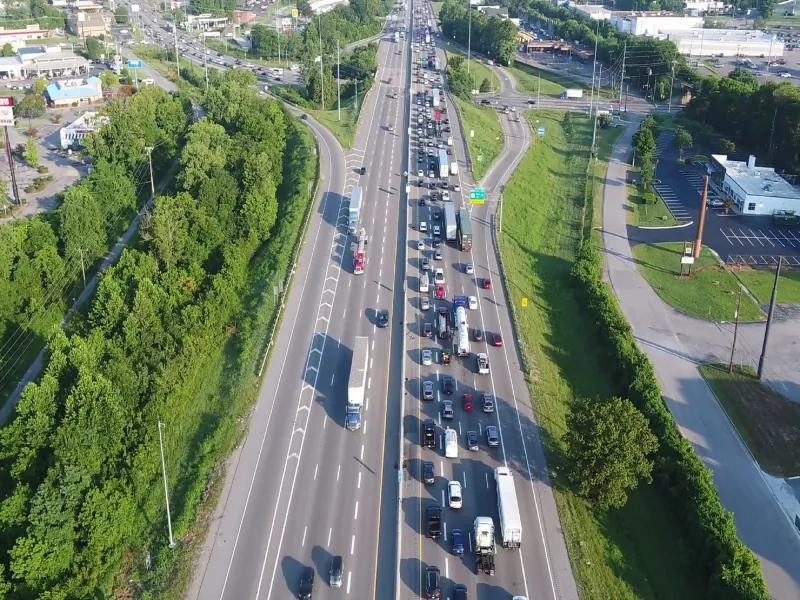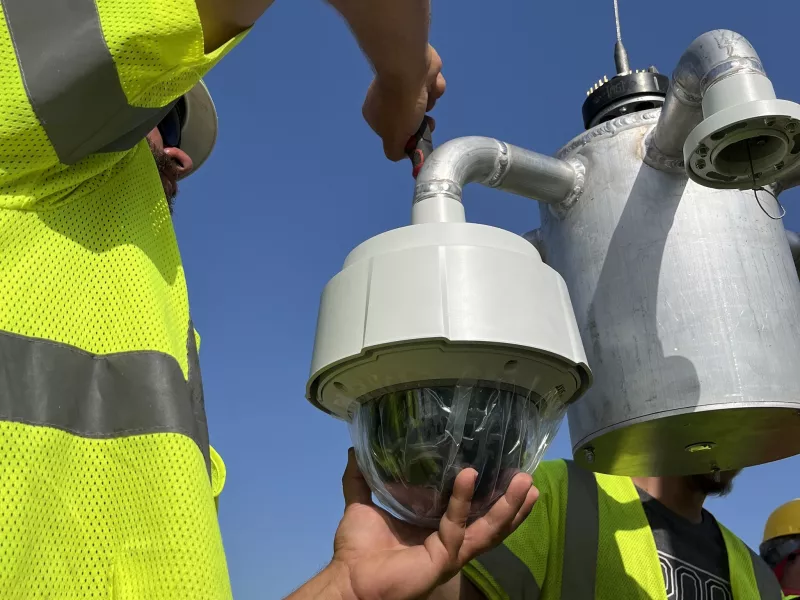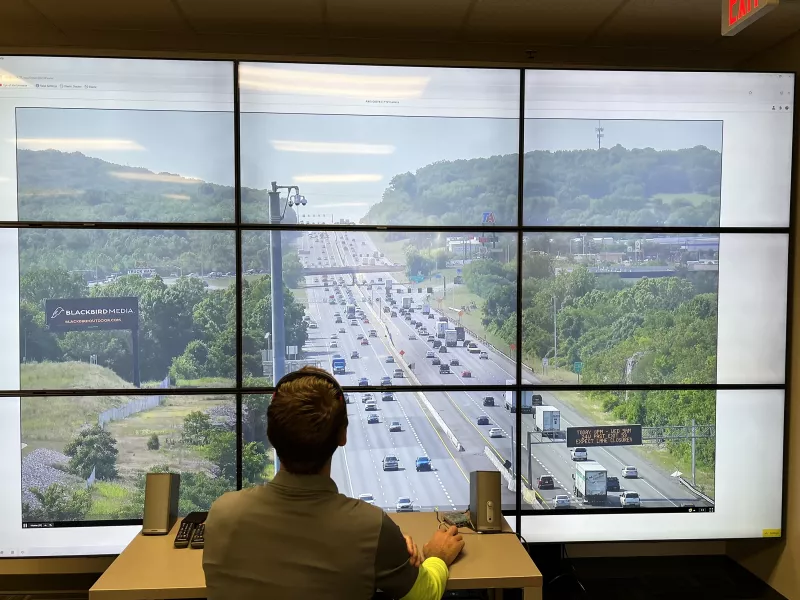
Unravelling the Cause of Phantom Traffic Jams
Vanderbilt University uses 294 Axis PTZ cameras along a four-mile stretch of Interstate 24 to conduct ground-breaking research on vehicle behavior and traffic flow to improve congestion management across Tennessee.

Local research with a global impact
Vanderbilt University in Nashville, Tennessee, is known for promoting academic research that fosters discoveries with the potential for global impact. So, when the Department of Civil and Environmental Engineering proposed a testbed that can study how to alleviate frustrating traffic jams on freeways, they were given the green light to do so.

Along with the Tennessee Department of Transportation (TDOT), the team secured a grant from the Federal Highway Administration Congestion Mitigation and Air Quality Improvement Program and the concept was built into a first-of-its-kind testbed known as the I-24 Mobility Technology Interstate Observation Network, or I-24 MOTION. The testbed – a four-mile stretch along Interstate 24 – employs clusters of video cameras to capture real-world conditions and vehicle behavior in actual freeway traffic instead of a laboratory or closed-course setting.
“We think of I-24 MOTION as an MRI for highway traffic,” says Dr. Dan Work, Professor of Civil and Environmental Engineering at Vanderbilt University. “There are a whole lot of features of traffic that are hard to detect and measure, even though motorists face them every day.”

He points to a particular phenomenon that he calls “phantom traffic jams,” where traffic stops for no apparent reason. “The stoppage happens because of the way motorists drive,” Work explains. “So, you need to be able to measure how small driving behaviors of one vehicle propagate to the next and amplify into large-scale phantom traffic jams.”
From proof-of-concept to full-scale deployment
To gain that insight, the Vanderbilt team needed to first prove the concept. Initial tests consisted of a single camera on a pole in the Chattanooga area and six temporary cameras on a freeway junction in Nashville. After successful tests, the team undertook a validation system of 18 cameras on three 110-foot poles on Interstate 24 in Nashville.

To allow for easy maintenance and adjustment of the cameras, Vanderbilt sought out a vendor who could provide a robust lowering mechanism for the camera clusters. “Typically, a camera lowering device is designed to carry one or two cameras. So, carrying six cameras was a big ask,” explains Mike Carlow, Critical Security Advisor Program Manager for Surveillance One, an Axis partner and the project’s system integrator.

Surveillance One helped walk the project team through the nuances of a larger scale deployment, evaluate technology, and bring in the right partners. MG SQUARED, the company who introduced the first lowering device specifically for cameras in 1996, accepted the challenge of carrying six cameras on a single lowering device and providing an ultra high-quality CAT6a-Shielded Ethernet disconnect block to ensure optimum signals for all six 4K Axis cameras. Satisfied with the results, TDOT and Vanderbilt were ready to move onto a full-scale rollout.
With the Axis PTZ cameras we’re capturing over 200 million miles of anonymized vehicular movement through our I-24 MOTION testbed annually. That enables us to study the causes of traffic congestion like we’ve never been able to do before.

Today, I-24 MOTION covers a four-mile stretch of I-24, including a series of on/off ramps. It consists of 276 AXIS Q60 pan/tilt/zoom (PTZ) cameras mounted on forty-three 110-135 ft tall poles equipped with the MG SQUARED camera lowering devices. Grouped in clusters of six along the highway and clusters of 12 at the on/off ramps, Vanderbilt-developed algorithms convert the camera video feeds to anonymously capture the time/space trajectory of every vehicle on the road.

“It’s not your traditional use of video cameras,” states Dr. Will Barbour, Research Scientist at Vanderbilt University focusing on the I-24 MOTION project. “We’re assembling thousands of anonymized points of data on the path of each vehicle through the testbed. We’re analyzing how vehicles interact with each other, hold following distances, and change lanes. We’re analyzing how traffic waves propagate through the roadways and how congestion forms and dissipates over time.”
To understand the vehicle-to-vehicle interactions on the microscopic level, I-24 MOTION also looks at broad categories of vehicles – such as pickups and semi-trucks, vans, motorcycles, and cars – and how their acceleration and breaking profiles influence the traffic stream.
The need for precision timing
To accurately measure the time/space trajectory of each vehicle requires a precise level of synchronization between video images as vehicles transition from one camera’s field of view to another.

“In a study like this, timing matters. We needed to understand how the Axis cameras keep time on their onboard computers and how they report that time when they capture video,” explains Dan Work. “If a camera’s timing is off by one frame, it creates a three-foot error in information captured about the vehicle driving down the freeway.”
The team spent long hours talking with Axis engineers in the U.S. and Sweden, taking a deep dive into the camera’s software to understand how to create a more accurate system. “Eventually we were able to upgrade every single camera on the network to new firmware that accomplished the exact time synchronization and reporting performance we needed for our analysis,” says Work.
Collaboration helps fast track traffic study
“Thanks to the collaborative efforts of all our partners – from Surveillance One, our integrator; to Axis and MG SQUARED, our technology providers; to Gresham Smith, our design and consultant partner; to the Tennessee DOT, our infrastructure owner champion – we were able to get I-24 MOTION up and running on a very aggressive timeline,” states Work. “Now we’re not only analyzing the traffic jams on I-24 every day, we’re also starting to pinpoint the exact causes.”

“With the Axis PTZ cameras we’re capturing over 200 million miles of anonymized vehicular movement through our I-24 MOTION testbed annually," clarifies Will Barbour. “That enables our group, and the broader transportation research community, to study the causes of traffic congestion like we’ve never been able to do before.”
While the project is still in its early days, one surprising bit of data that I-24 MOTION can quantify is a much higher frequency of traffic jams than what the transportation science community had previously estimated. Work goes on to say, “We’re just scratching the surface. Being able to characterize how traffic jams are created will help us advance technologies to reduce them and make the daily commute less painful.”
Impacts for the future
“To my knowledge, I-24 MOTION is the densest, highest resolution, on-road transportation testbed in the country,” states Will Barbour. “It’s not only helping us deeply understand the phenomenon of phantom traffic jams, it’s also serving as an experimental platform that’s open to the public. Anyone from academia to state DOTs to private companies like auto manufacturers can run tests on this open road environment.”
Currently, there is no expiration date planned for the project since it continues to help transportation scientists and other interested parties unlock the mysteries of freeway tie ups and their impact on motorist behavior, air quality and roadway safety. “I-24 MOTION is operational and can support a wide variety of use cases,” shares Barbour. “It’s a research tool and asset for the TDOT to continue studying their roadways, how traffic ebbs and flows, and what they can do to reduce annoying congestion.”
Products & solutions

